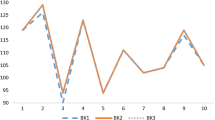Abstract
Expediting is defined as using overtime or subcontracting to supplement regular production. This is usually done when the number of backorders has grown to be unacceptably large. In this paper, we consider analytic models for deciding when and how to expedite in a single-product make-to-order environment. We derive the structure of the optimal expediting policy in both continuous- and discrete-time cases. The continuous-time model corresponds best to subcontracting and the discrete-time model corresponds to either overtime or subcontracting. Models for performance analysis of the continuous-time case are also given.
Similar content being viewed by others
References
Akkan, C. (1996) Overtime scheduling: an application in finite-capacity real-time scheduling. Journal of the Operational Research Society, 47, 1137-1149.
Arreola-Risa, A. and DeCroix, G.A. (1998) Make-to-order versus make-to-stock in a production-inventory system with general production times. IIE Transactions, 30, 705-713.
Bitran, G.R. and Tirupati, D. (1991) Approximations for networks of queues with overtime. Management Science, 37, 282-300.
Bradley, J.R. (1997) Managing assets and subcontracting policies. Ph.D. dissertation, Stanford University, Stanford, CA.
Bradley, J.R. (1998a) A discrete-time subcontracting model. Working Paper, Cornell University, Ithaca, NY.
Bradley, J.R. (1998b) Optimal control of an M/M/1 subcontracting model. Working Paper, Cornell University, Ithaca, NY.
Bradley, J.R. and Glynn, P.W. (1999) Managing the manufacturer-subcontractor relationship and the manufacturer's optimal capacity, inventory, and subcontracting policies. Working Paper, Cornell University, Ithaca, NY.
Daniel, K.H. (1963) A delivery-lag inventory model with emergency, in Multistage Inventory Models and Techniques, Scarf, H.E., Gilford, D.M. and Shelly, M.W. (eds,).
Dellaert, N.P. and Melo, M.T. (1998) Make-to-order policies for a stochastic lot-sizing problem using overtime. International Journal of Production Economics, 56–57, 79-97.
Duenyas, I., Hopp, W.J. and Bassok, Y. (1997) Production quotas as bounds on interplant JIT contracts. Management Science, 43, 1372-1386.
Duenyas, I., Hopp, W.J. and Spearman, M.L. (1993) Characterizing the output process of a CONWIP line with deterministic processing and random outages. Management Science, 39, 975-988.
Fukuda, Y. (1964) Optimal policies for the inventory problem with negotiable leadtime. Management Science, 10, 690-708.
Heyman, D.P. and Sobel, M.J. (1984) Stochastic Models in Operations Research, Vol. I, McGraw Hill, New York.
Hopp, W.J., Spearman, M.L. and Duenyas, I. (1993) Economic production quotas for pull manufacturing systems. IIE Transactions, 25, 71-79.
Iglehart, D.L. (1963) Optimality of (s,S) policies in the infinite horizon dynamic inventory problem. Management Science, 9, 259-267.
Jordan, W. (1997) Personal communication.
Karmarkar, U.S., Kekre, S. and Kekre, S. (1987) Capacity analysis of a manufacturing cell. Journal of Manufacturing Systems, 6, 165-175.
Lippman, S.A. (1975) Applying a new device in the optimization of exponential queueing system. Operations Research, 23, 687-710.
Moinzadeh, K. and Schmidt, C.P. (1991) An (S-1,S) inventory system with emergency orders. Operations Research, 39, 308-321.
Puterman, M.L. (1994) Markov Decision Processes, John Wiley, New York.
Rubin, G. and Robson, D.S. (1990) A single server queue with random arrivals and balking: confidence interval estimation. Queueing Systems, 7, 283-306.
Van Mieghem, J.A. (1999) Coordinating investment, production and subcontracting. Management Science, 45, 954-971.
Zabel, E. (1962) A note on the optimality of (s,S) policies in inventory theory. Management Science, 9, 123-125.
Zheng, Y-S. (1991) A simple proof for optimality of (s,S) policies in infinite-horizon inventory systems. Journal of Applied Probability, 28, 802-810.
Author information
Authors and Affiliations
Corresponding author
Rights and permissions
About this article
Cite this article
Arslan, H., Ayhan, H. & Olsen, T.L. Analytic Models for When and How to Expedite in Make-to-Order Systems. IIE Transactions 33, 1019–1030 (2001). https://doi.org/10.1023/A:1010946603476
Issue Date:
DOI: https://doi.org/10.1023/A:1010946603476



